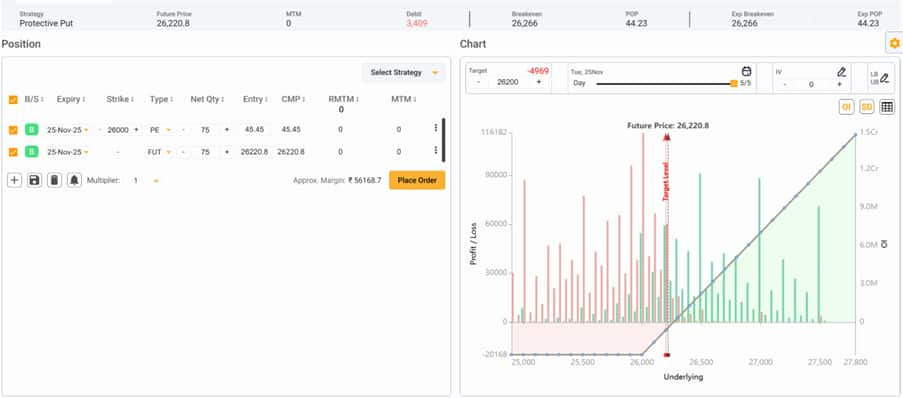3-step guide to construct a pro-volatility option portfolio for bargain hunting
Such are the times where conventional wisdom says that we should now start nibbling in the beaten-down names. More often than not, we eye good stock which is well-capitalized, big-sized, and most probably an index constituent
SHUBHAM AGARWAL | 26-Aug-19
Reading Time: 3 minutes

Bargain hunting has always been attracting all of us, but if we apply that in the equity markets, it leads to disastrous outcomes at times. Market set-ups, like the one which we are in right now, often show a price that is over-pessimistic.
Such are the times where conventional wisdom says that we should now start nibbling in the beaten-down names. More often than not, we eye good stock which is well-capitalized, big-sized, and most probably an index constituent.
The million-dollar question here is though who decides “how much is too much?”
Meaning, even at the lowest prices of the year one still has to account for a potential of even deeper cuts.
This argument now brings us to the options arena.
We will deal with this possibility of down move with a three-stepped mechanism.
Step 1: Limit the downside risk of fresh Bets
This problem has a simple solution. We will go ahead and create positions in Calls of those beaten-down stocks that we want to buy. Now, by the virtue of being an option, we would in any case not lose more than what we paid for as the premium.
However, the market is not a place where we buy the stock and the next day it will start moving higher. With options, we get an additional problem of dealing with time spent in getting a rebound.
Remember, options always get pricier as the underlying prices go down due to increments in the risk premium.
On the other hand, on its way up the same premiums would deplete. To find a solution to these two issues we resort to Step #2.
Step 2: Convert the long Calls into large spreads
More often than not, in times like these, Out of the Money strike Calls or strike prices slightly away from the current price, would command a good premium. So, the remedy to reduce the premium should be dealt with by going short on another option.
Now create a spread by selling around 7-10 percent higher Call against the Calls bought. This would limit the upside but the expiries being time-bound even capitalization of these spreads in themselves would create fantastic returns.
Now, we have limited the downside but with a portfolio of Call Spreads there still comes a big sunk cost to be dealt with in case the fear of continuation of preceding pessimism is met with. To compensate for this, we go to the third and the final step.
Step 3: Provide for limited probability downside
Total up to the entire amount of premium at stake. Add a final position to this pro-volatility portfolio. This position would be of an index Put spread.
Traders should devise a spread by buying position in close to current level strike Index Put and Sell position in a lower same index same expiry Put such that the maximum profit of this spread equates the max Premium loss of all the Call spreads combined.
These steps structuring of option portfolio is something that I have been resorting to.
Typically, the final pay-off would be very encouraging as in the case of volatility there is no great risk. On the upside, there would be big profits and on the lower side, there would be no profit–no loss.
The only pain point is, if nothing happens till expiry, all the premiums (net of buy-sell) is lost. Most of the times, I have encountered pay-offs where this loss is not more than 30-35 percent of the maximum profit of the position.
Structuring this pro-volatility options portfolio is surely a tedious task but is the most prudent way to indulge in bargain hunting.
Learn and read more about futures price from Quantsapp classroom which has been curated for understanding of futures from scratch, to enable option traders grasp the concepts practically and apply them in a data-driven trading approach.
Recent Articles

Best trending option trading strategies: Shubham Agarwal
29-Nov-25

3 best ways to hedge using Options: Shubham Agarwal!
22-Nov-25

When in doubt to write, do Iron Fly: Shubham Agarwal!
15-Nov-25

Identify potential turning points with advance-decline: Shubham Agarwal
08-Nov-25

Slow and spreads more efficient: Shubham Agarwal
01-Nov-25

Use implied volatility as probable top finder: Shubham Agarwal
25-Oct-25

How to trade potential breakout post consolidation: Shubham Agarwal!
18-Oct-25

Use Options OI for intraday trading: Shubham Agarwal
11-Oct-25

SHUBHAM AGARWAL is a CEO & Head of Research at Quantsapp Pvt. Ltd. He has been into many major kinds of market research and has been a programmer himself in Tens of programming languages. Earlier to the current position, Shubham has served for Motilal Oswal as Head of Quantitative, Technical & Derivatives Research and as a Technical Analyst at JM Financial.
Recent Articles

Best trending option trading strategies: Shubham Agarwal
29-Nov-25 09:32:00

3 best ways to hedge using Options: Shubham Agarwal!
22-Nov-25 09:11:00

When in doubt to write, do Iron Fly: Shubham Agarwal!
15-Nov-25 10:48:00

Identify potential turning points with advance-decline: Shubham Agarwal
08-Nov-25 10:35:00

Slow and spreads more efficient: Shubham Agarwal
01-Nov-25 10:35:00

Use implied volatility as probable top finder: Shubham Agarwal
25-Oct-25 09:56:00

How to trade potential breakout post consolidation: Shubham Agarwal!
18-Oct-25 09:20:00











